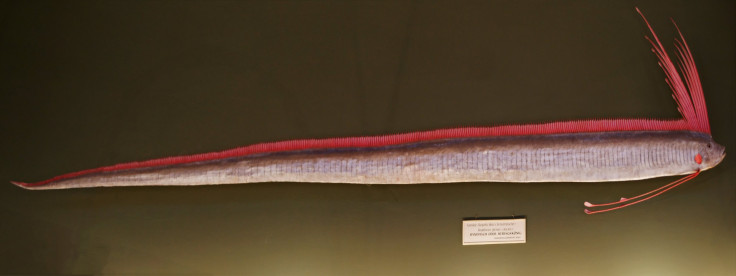
Scientists bore witness to a glowing, 8-foot-long serpent elegantly gliding through the ocean about 200 feet below sea level. The alien creature was apparently fascinated by the crew's equipments as it sashayed through the water, displaying its elegant marking and bizarre posture.
The mysterious creature of the deep, however, is no fabled sea serpent. It's an oarfish. Mark Benfield, a biologist from Louisiana University, has been tracking strange ocean dwellers since 2006 through the SERPENT project, which works in conjunction with several oil companies station in the Gulf of Mexico to scan the waters for life, the Los Angeles Times reports. Benfield also discovered a long, white parasitic isopod common on fish, but something he has never seen on an oarfish.
The oarfish is characterized by its eel-like body, which it orients vertically, facing the surface, to maneuver the ocean. It allows the fish to scan the water for krill and small crustaceans that it feasts on. Its awkward positioning could also be a way for the fish to appear smaller and therefore unappetizing to predators, scientists say. Benfield recently wrote a paper for the Journal of Fish Biology on the oarfish encounter.
"The striking thing is they swim by undulating their dorsal fin like a propeller, and they can change direction instantly," Benfield said. "Most of the time they move slowly and stealthily, but when they want to, they can move fast."
RELATED: Mythical Creatures Real Or Not? See A List Of Beasts That Are Rumored To Exist [PHOTOS]
RELATED: UFO Mexican Volcano: Does Video Footage Show UFO Entering Mexico's Popocatepetl Volcano? [VIDEO]
RELATED: Alien Body Found? See Pictures Of Alien Corpse Chinese Man Claims To Have Found In Yellow River [PHOTOS]
Benfield usually gets zooplankton and shrimp when out on expeditions, which have been bolstered after oil companies allowed him to use their remotely operated vehicles, or ROVs. The ROVs are not exactly suited to find wildlife, especially since they are noise, shine bright lasers at everything they track and are the size of a small car. Benfield, however, said the ROVs make it easier to get time on the hundreds scattered in the ocean. Since he began working with oil companies, he was able to document 40 hours of undersea footage.
This isn't the first time Benfield came into contact with such a fish. Since 2008, he's seen oarfish on four different occasions. The most recent of instances was in 2011 when he and a team were working with the Natural Resource Damage Assessment to gauge the effects of the Deepwater Horizon oil spill.
In the video, the oarfish is reacting to the sound of the bright, loud object in the water. It becomes more visible around the 5-minute mark before losing interest in the object and swimming away.
"It starts by backing away from us tail-first, and then finally it got fed up and took off," said Benfield.
© 2025 Latin Times. All rights reserved. Do not reproduce without permission.




